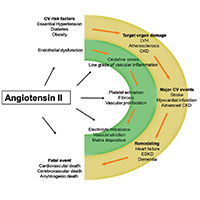Effects of inhibition of the renin-angiotensin system on hypertension-induced target organ damage: clinical and experimental evidence

Submitted: August 13, 2020
Accepted: October 3, 2020
Published: February 10, 2021
Accepted: October 3, 2020
Abstract Views: 1105
PDF: 744
Publisher's note
All claims expressed in this article are solely those of the authors and do not necessarily represent those of their affiliated organizations, or those of the publisher, the editors and the reviewers. Any product that may be evaluated in this article or claim that may be made by its manufacturer is not guaranteed or endorsed by the publisher.
All claims expressed in this article are solely those of the authors and do not necessarily represent those of their affiliated organizations, or those of the publisher, the editors and the reviewers. Any product that may be evaluated in this article or claim that may be made by its manufacturer is not guaranteed or endorsed by the publisher.
Similar Articles
- Giovanni Esposito, Luigi Di Serafino, Giuseppe Gargiulo, Anna Sannino, Gabriele Giacomo Schiattarella, Anna Franzone, Cinzia Perrino, Massimo Chiariello, Rotational atherectomy for the treatment of isolated femoral artery traumatic lesion: a case report , Monaldi Archives for Chest Disease: Vol. 72 No. 3 (2009): Cardiac series
- A.M. Moretti, S. Tafuri, D. Parisi, C. Germinario, Epidemiology of Pulmonary Embolism in Apulia from analysis of current data , Monaldi Archives for Chest Disease: Vol. 73 No. 1 (2010): Pulmonary series
- Annabella Braschi, Vincenzo Cristian Francavilla, Maurizio Giuseppe Abrignani, Renzo Lombardo, Furio Colivicchi, Giuseppe Francavilla, Usefulness of QT dispersion in clinical practice , Monaldi Archives for Chest Disease: Vol. 72 No. 3 (2009): Cardiac series
- Gennaro Ratti, Antonio Maglione, Emilia Biglietto, Cinzia Monda, Ciro Elettrico, Federica Ratti, Cosimo Fulgione, Mario Mallardo, Paolo Tammaro, Long term dual antiplatelet therapy after myocardial infarction: retrospective analysis in an outpatient population , Monaldi Archives for Chest Disease: Vol. 92 No. 1 (2022)
- Marco Umberto Scaramozzino, Guido Levi, Ubaldo Romeo Plastina, Giovanni Sapone, A rare case of asthmatic patient with left Chilaiditi’s syndrome , Monaldi Archives for Chest Disease: Early Access
- Gennaro Ismeno, Antonio Falco, Francesco Paolo Tritto, Antonio d’Angelo, Francesco Longobardi, Girolamo Damiani, Joseph Marmo, Rosario Gregorio, Luigi Piazza, The use of “LAST†operation in high risk patient , Monaldi Archives for Chest Disease: Vol. 66 No. 1 (2006): Cardiac series
- Amira Aishah Che Ani, Sakinah Mohd Akhir, Winnie Chiang Li-Xue, Nur Zurairah Shahidan, Azman Abd Hamid, Diffuse alveolar haemorrhage and myocardial infarction: life-threatening effects from self-injected hyaluronic acid dermal filler , Monaldi Archives for Chest Disease: Vol. 91 No. 4 (2021)
- Vinh Nguyen-Nhu, Lam-Phuoc Nguyen, Sy Duong-Quy, Pham Le An, Tri Bui-Minh, Classification of chronic obstructive pulmonary disease as ABCD according to the GOLD 2011 and 2017 versions in patients at the University Medical Center in Ho Chi Minh City, Vietnam , Monaldi Archives for Chest Disease: Vol. 94 No. 2 (2024)
- Antonio D’Aloia, Barbara Piovanelli, Riccardo Rovetta, Ivano Bonadei, Enrico Vizzardi, Antonio Curnis, Marco Metra, A case of iatrogenic severe mitral regurgitation , Monaldi Archives for Chest Disease: Vol. 80 No. 3 (2013): Cardiac series
- Teresa Strisciuglio, Gennaro Galasso, Dario Leosco, Roberta De Rosa, Giuseppe Di Gioia, Valentina Parisi, Stefania De Luca, Tullio Niglio, Chiara De Biase, Rossella Luciano, Giuseppe Rengo, Bruno Trimarco, Federico Piscione, Adipokines and coronary artery disease , Monaldi Archives for Chest Disease: Vol. 78 No. 3 (2012): Cardiac series
<< < 16 17 18 19 20 21 22 23 24 25 > >>
You may also start an advanced similarity search for this article.

 https://doi.org/10.4081/monaldi.2021.1570
https://doi.org/10.4081/monaldi.2021.1570




